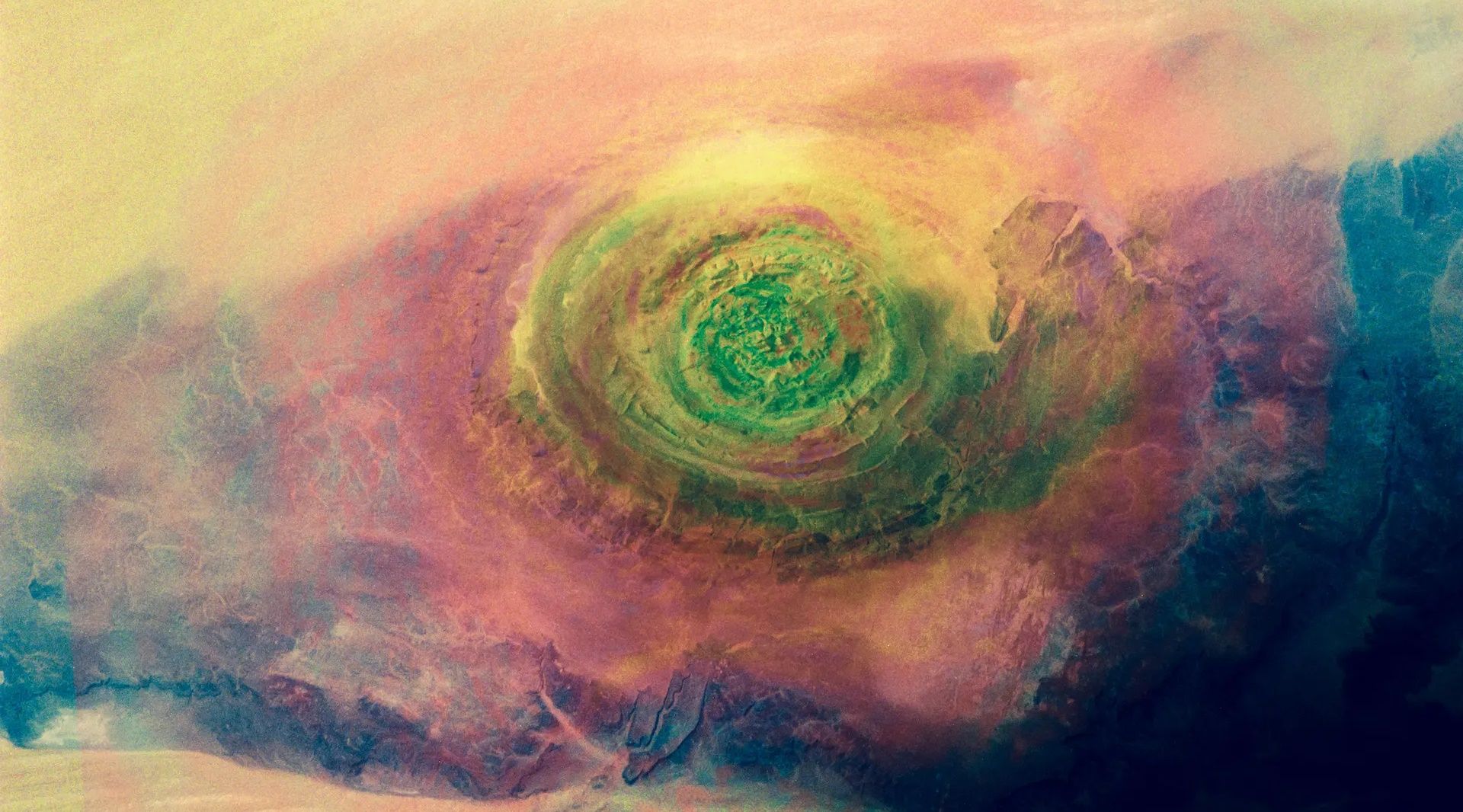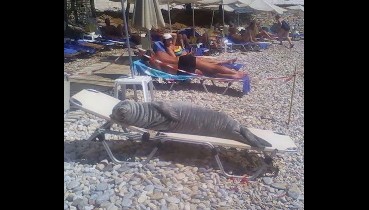

Richat Structure | Mauritania
Also known as the Eye of Africa, the Richat Structure is a strange formation in the desert rock near the small town of Ouadane in Mauritania. The inverse dome is 25 miles in diameter and has exposed various layers of rock that appear like concentric rings. It's one of the easiest natural structures to see from space, but amazingly it's tough to see from ground level. And if you were there, you'd probably be unable to notice anything different about it from the surrounding. Entirely how it was formed has been the subject of scientific debate ever since it was first discovered in the 1930s, the first assumption was that it was an impact crater from a meteorite, but the lack of evidence of any super heated rocks has ruled this out.
Instead, it's been formed by millions of years of erosion of softer rock. That was probably deposited when the region was underwater. Quite why this happened in such a circular fashion is still unclear. Some ridges and valleys follow the concentric lines of the Richat Structure, and evidence has been found that humans have lived here for hundreds of thousands of years.
Ancient artifacts that have been unearthed date back to the stone age, such as tools and spheres strangely. However, none have been found at the center of this depression, which also discounts any possibility that this was a prehistoric mind of some sort. With such delicate rock, there are calls to make the structure a protected site to ensure it can be studied for years to come and hopefully reveal some of the secrets as to how this strange place came to be.
 The Blue Eye of the Sahara or known as the Richat Structure that is a geological formation in the Sahara Desert. The formation stretches across a 40 km-wide region in Mauritania. It was first photographed by Gemini astronauts who used it as a landmark in the 1960s, to monitor the progress of the opening sequences. Later, the Landsat satellite took additional images and provided information about the size, height, and extent of the formation.
The Blue Eye of the Sahara or known as the Richat Structure that is a geological formation in the Sahara Desert. The formation stretches across a 40 km-wide region in Mauritania. It was first photographed by Gemini astronauts who used it as a landmark in the 1960s, to monitor the progress of the opening sequences. Later, the Landsat satellite took additional images and provided information about the size, height, and extent of the formation.The geologists initially believed that the Eye of the Sahara was a blow crater that was created when an object from space struck the surface. However, the long studies of rocks within the structure show that their origins are entirely World-based. The Richat Structure is a light elliptical dome, deeply eroded in 40 km diameter (25 ml). The sedimentary rock at this dome extends from the Late Proterozoic in the center of the dome to the Ordovis sandstone in the middle. The sedimentary rocks forming this structure run out at 10–20 °. Differential wear of resistant quartzite layers has created a high puffy circular cuestas. The center consists of a siliceous breeder covering an area of at least 30 kilometers (19 mi) in diameter.

Structure
Exposed within the interior of the Richat Structure are a variety of intrusive and extrusive igneous rocks. They include rhyolitic volcanic rocks, gabbros, carbonatites and kimberlites. The rhyolitic rocks consist of lava flows and hydrothermally altered tuffaceous rocks that are part of two distinct eruptive centers, which are interpreted to be the eroded remains of two maars. According to field mapping and aeromagnetic data, the gabbroic rocks form two concentric ring dikes. The inner ring dike is about 20 m in width and lies about 3 km from the center of the Richat Structure. The outer ring dike is about 50 m in width and lies about 7 to 8 km from the center of this structure. Thirty-two carbonatite dikes and sills have been mapped within the Richat Structure. The dikes are generally about 300 m long and typically 1 to 4 m wide. They consist of massive carbonatites that are mostly devoid of vesicles. The carbonatite rocks have been dated as having cooled between 94 and 104 million years ago. A kimberlitic plug and several sills have been found within the northern part of the Richat Structure. The kimberlite plug has been dated to around 99 million years old. These intrusive igneous rocks are interpreted as indicating the presence of a large alkaline igneous intrusion that currently underlies the Richat Structure and created it by uplifting the overlying rock.

Formation
Millions of years ago, volcanic activity from deep beneath Earth’s surface lifted the entire landscape around the Eye. These regions were not deserts, as they are today. Instead, they were likely much more temperate, with abundant flowing water. Layered sandstone rocks were deposited by blowing winds and on the bottoms of lakes and rivers during the temperate. The subsurface volcanic flow eventually pushed up the overlying layers of sandstone and other rocks. After the volcanism died down, wind and water erosion began to eat away at the domed layers of rock. The region began to settle down and collapse in on itself, creating the roughly circular “eye” feature.
 The ancient rocks within the Eye of the Sahara have provided researchers with information about its origins. The earliest formation of the Eye began when the supercontinent Pangaea began to pull apart. As Pangaea broke up, the Atlantic Ocean waters began to flow into the region. While Pangaea was slowly pulling apart, magma from deep beneath the surface began to push up from the Earth’s mantle, which formed a circle-shaped rocky dome surrounded by layers of sandstone. As erosion took its toll on the igneous rocks and sandstones, and as the dome subsided, circular ridges were left behind, giving the Richat Structure its sunken circular shape. Today, the eye is somewhat sunken below the level of the surrounding landscapes.
The ancient rocks within the Eye of the Sahara have provided researchers with information about its origins. The earliest formation of the Eye began when the supercontinent Pangaea began to pull apart. As Pangaea broke up, the Atlantic Ocean waters began to flow into the region. While Pangaea was slowly pulling apart, magma from deep beneath the surface began to push up from the Earth’s mantle, which formed a circle-shaped rocky dome surrounded by layers of sandstone. As erosion took its toll on the igneous rocks and sandstones, and as the dome subsided, circular ridges were left behind, giving the Richat Structure its sunken circular shape. Today, the eye is somewhat sunken below the level of the surrounding landscapes.How do I go to the Eye of Sahara
The Western Sahara no longer has the temperate conditions that existed during the Eye’s formation. However, it is possible to visit the dry, sandy desert that the Eye of the Sahara calls home but it’s not a luxurious trip. Travelers must first gain access to a Mauritanian visa and find a local sponsor. Once admitted, tourists are advised to make local travel arrangements. Some entrepreneurs offer airplane rides or hot air balloon trips over the Eye, giving visitors a bird’s-eye view. The Eye is located near the town of Oudane, which is a car ride away from the structure, and there is even a hotel inside the Eye.
Future Status
The Eye of the Sahara attracts both tourists and geologists who flock to the eye to study unique geological features. However, the eye is not under much threat by humans because it has very little water or rainfall in an area where the desert is sparsely inhabited.
This leaves the eye open to variables of nature. The ongoing effects of erosion threaten the landscape as elsewhere on the planet. Desert winds, especially climate change, can bring more sand dune to the region because it causes desertification in the region. In the distant future the Sahara’s eye is full of sand and dust. Future travelers will find only a windy desert that buries one of the most striking geological features on the planet.
Recommended Videos
 Cave Of Crystals: This Fascinating Cave In Mexico Is Straight Out Of Science Fiction1056 views
Cave Of Crystals: This Fascinating Cave In Mexico Is Straight Out Of Science Fiction1056 views 33 Times People Witnessed Something Interesting At The Beach And Just Had To Share It2704 views
33 Times People Witnessed Something Interesting At The Beach And Just Had To Share It2704 views-
Advertisements
 Extremely Rare Albino Turtle Was Found In India And It Looks Like A Slice Of Melted Cheese377 views
Extremely Rare Albino Turtle Was Found In India And It Looks Like A Slice Of Melted Cheese377 views 50 Stunning Spine Tattoo Ideas That Will Make You Want To Get Inked5808 views
50 Stunning Spine Tattoo Ideas That Will Make You Want To Get Inked5808 views Harpy Eagle Is World’s Largest Eagle, People Even Think It’s A Person Cosplaying A Bird..20028 views
Harpy Eagle Is World’s Largest Eagle, People Even Think It’s A Person Cosplaying A Bird..20028 views 27 Pairs Of Tights For People Who'd Rather Be Cold Than Wear Pants683 views
27 Pairs Of Tights For People Who'd Rather Be Cold Than Wear Pants683 views Rocks Made of Melted Plastic Waste Found on Remote Island139 views
Rocks Made of Melted Plastic Waste Found on Remote Island139 views Crochet Lovers Share Remarkable And Beautiful Works1078 views
Crochet Lovers Share Remarkable And Beautiful Works1078 views



